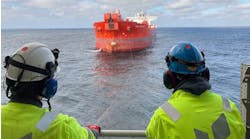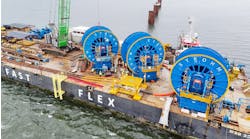Jeremy Beckman - London
Norway reserves hold steady
Exploration on the Norwegian shelf last year led to 25 discoveries, including four in the Barents Sea, according to the latest survey by the Norwegian Petroleum Directorate (NPD). Most were relatively small accumulations, with combined reserves estimated at 50 MMcm (314 MMbbl) of oil and 72 bcm (2.5 tcf) of gas. But this represents a substantial increase in resource growth compared with the yield for 2007, NPD points out.
Petroleum resources across the shelf (recoverable) totaled around 13 bcmoe (81.76 Bboe) at year-end, virtually unchanged from 2007. As of Dec. 31, 11 fields were under development: of these, Rev and Yttergrytta have since started production, while Alve, Tyrihans, Volund, and Yme should be onstream later this year.
There were reserves upgrades on several fields, led by Alvheim, Tyrihans, and Ula. Norway’s accumulated gross oil reserves growth since 2005 now stands at 232 MMcm (1.46 Bbbl), NPD adds. The government’s goal is to mature 800 MMcm (5 Bbbl) of oil as reserves over the 10-year period to 2015.
NPD has also identified 73 discoveries not yet approved for development, of which 34% are in the planning phase.
Troll investment scaled down
StatoilHydro and its partners in the Troll license in the North Sea have modified their re-development plans. Gas injection at Troll West will proceed in order to increase oil recovery by 17 MMbbl, but the proposed replacement of flowlines in the gas wells on the Troll A platform has been scrapped. This is due to changing market conditions since the plans were submitted last summer, notably lower oil prices and higher costs.
The new 65-km (40-mi) pipeline taking rich gas from the Troll A platform to the Gassco-operated processing plant onshore at Kollsnes will go forward, also involving modifications at both facilities. Aker Solutions recently won a contract to modify and develop the gas plant at Kollsnes, which processes supplies from Troll, Kvitebjorn, and Visund, under a NOK1.5-billion ($212-million) program due to be completed by end-2011. Following the changes, the overall investment budget for Troll has been sharply reduced to NOK3.8 billion ($538 million).
Third success for Dana on Rinnes
Dana Petroleum has discovered more oil in block 210/24a in the UK northern North Sea. The well on the South East Rinnes prospect targeted a Lower Brent reservoir sequence, 4 km (2.49 mi) from the company’s producing Hudson field.
After encountering a full oil column in high-quality Brent sands, a sidetrack was drilled down-dip to the north to establish the oil-water contact. This encountered the Lower Brent sequence as planned – wireline logs and pressure data confirmed an oil column of over 400 ft (122 m) true vertical thickness.
The latest find, combined with earlier successes on the nearby East and West Rinnes and Melville structures, suggests probable oil in place of 80 MMbbl. Dana is evaluating development options, including a tieback to a nearby production center – Hudson produces through TAQA’s Tern platform – or a dedicated FPSO.
In the same region, Dana has agreed to sell its 50% stake in two blocks (211/8a and 211/13a) to partner Valiant Exploration. They contain Banquo and Helena, two undeveloped Triassic oil and gas-condensate fields discovered by Ranger Oil and Shell. Valiant will seek a new partner to help appraise and develop the fields, potentially alongside its Tybalt prospect in adjacent block 211/8c.
Baird lined up for storage
British Gas’ parent company Centrica has acquired a 70% interest from Perenco in a potential subsea storage project. The two companies propose to convert the largely depleted Baird field in the southern North Sea into what would be the UK’s second largest gas storage facility.
Pre-development studies will run until summer 2010. The proposed facility would have capacity of around 60 bcf, half the volume available in the Rough field in the same sector, but better adapted to market volatility, according to Centrica. Last year the company also announced plans for a similar project on the Bains gas field in the Irish Sea off northwest England.
Hansa farms into German blocks
Hansa Hydrocarbons is looking to revive exploration in the German sector of the North Sea. The London-based company has a farm-in agreement with Wintershall which would give it 20% of nine blocks in Germany’s “H” and “L” quadrants. In return, Hansa will contribute to the cost of a well late this year to appraise the L-1 Alpha discovery.
The blocks cover an area of 2,240 sq km (865 sq mi), and include various finds, but there has been no drilling activity for over 30 years. L-1 Alpha proved gas in lower Rotliegendes sandstones with quantities of nitrogen, which was also present in the other wells.
BIS Salamis recently performed composite and paint repairs on a vent stack at Shell’s Leman Echo platform in the southern North Sea. To protect staff and the 36-m (118-ft) tall stack against high winds, a Layher Protect system was erected, comprising a series of steel sheets held within an aluminum framework, then connected to a scaffold structure. The temporary construction allowed rope access and grit blasting to be conducted without impact on other planned activities on the small platform, where space is tight. Lighting and ventilation systems also were installed along the lower section to ensure round-the-clock access by the rope access teams.





